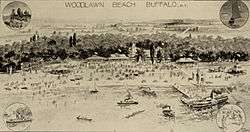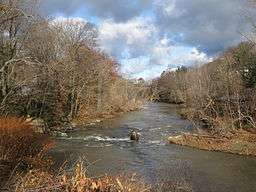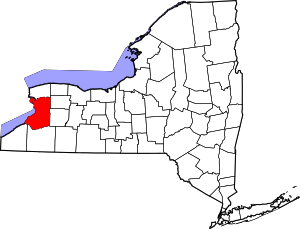Hamburg, New York
| Hamburg, New York | |
|---|---|
| Town | |
|
| |
| Motto: The Town That Friendship Built | |
 Location of Hamburg in Erie County and New York | |
 Hamburg, New York Location in the United States | |
| Coordinates: 42°44′40″N 78°51′30″W / 42.74444°N 78.85833°WCoordinates: 42°44′40″N 78°51′30″W / 42.74444°N 78.85833°W | |
| Country | United States |
| State | New York |
| County | Erie |
| Incorporated | 1812 |
| Government | |
| • Type | Town board |
| • Body | Hamburg Town Board |
| • Town Supervisor | Steven Walters (Republican) |
| Area | |
| • Total | 41.4 sq mi (107.1 km2) |
| • Land | 41.3 sq mi (107.0 km2) |
| • Water | 0.04 sq mi (0.1 km2) |
| Elevation | 732 ft (223 m) |
| Population (2010) | |
| • Total | 56,936 |
| • Density | 1,378/sq mi (532.0/km2) |
| Time zone | EST (UTC-5) |
| • Summer (DST) | EDT (UTC-4) |
| ZIP code | 14075 |
| Area code | 716 |
| FIPS code | 36-31654 |
| GNIS feature ID | 0952086 |
| Website |
townofhamburgny |
Hamburg is a town in Erie County, New York, United States. As of the 2010 census, the town had a total population of 56,936.[1] It is named after the city of Hamburg, in Germany.[2] The town is on the western border of the county and is south of Buffalo. Hamburg is one of the Southtowns in Erie County. The villages of Hamburg and Blasdell are in the town.
History

Historical evidence shows that the area was settled originally by the Erie people.[3] Around 1805 the settlement was known as "Barkerville", named after Zenas Barker, the postmaster. On the site of this building today is the Dock at the Bay. The first landowner in the area was John Cummings, who built the first grist mill in 1806.
The town of Hamburg was formed by government decree on March 20, 1812, from the (now defunct) town of Willink. The first town meeting took place on April 7, 1812, at Jacob Wright's tavern at Wright's Corners, which was renamed Abbott's Corners, and now Armor. One of the early noted activities of the town board in that same year was to place a $5 bounty on wolf hides, due to the complaints of the local settlers who were being bothered by them.
In 1815, mail routes were established. The earliest settlers in the area were from New England. Germans started arriving in the 1830s and set up many successful farms. On November 29, 1824, a meeting was held in Abbott's Corners at the home of early settler Seth Abbott. At a vote of those present, agreement was reached to form a library with the sum of $102.[4]
By 1850, the town was reduced by the formation of the towns of Orchard Park and West Seneca. Around 1852, the Erie Railroad was built through the area. In 1868 the Erie County Fair came to the town and has been located there since then. In 1875 the weekly publication of the Erie County Independent began. This is now known as The Sun. Telephone service in the area started in 1886.
The village of Hamburg set itself off from the town in 1874 by incorporating as a village.
Starting in 1890 and to support the growing regional steel industry, Polish and Italians began to arrive in the area.[5]
In 1897, a group of women known as the Nineteenth Century Club started a permanent free public library, known as the Hamburg Free Library. Until 1901 it was located in various rented buildings. The Hamburg Free Library was moved into a Carnegie library on Center Street on November 8, 1915, where it remained until 1966 when the current library at 102 Buffalo Street was opened.
In 1898, the community of Blasdell set itself apart from the town by incorporating as a village.
A trolley car system was established in the early 1900s.
The Kleis Site, containing the remnants of a 17th-century Iroquoian village and burial ground, was listed on the National Register of Historic Places in 1979.[6]
In 2003, Joe Haptas, a spokesman for the animal rights group People for the Ethical Treatment of Animals (PETA), sent a letter to then-Town Supervisor Patrick Hoak and asked that the name of Hamburg be changed to "Veggieburg". PETA offered the Hamburg Central School District $15,000 worth of free veggie burgers as an incentive for the name change. Hoak declined the name change.[7]
In July 2012, Main Street in the village of Hamburg from Lake Street to Buffalo Street was granted state approval for nomination as a national historic district.[8]
Geography

According to the United States Census Bureau, 41.4 square miles (107.1 km2), of which 41.3 square miles (107.0 km2) is land and 0.03 square miles (0.07 km2), or 0.07%, is water.[1]
Lake Erie forms the western border of the town, and Eighteen Mile Creek forms the southern boundary.[9]
Communities and locations
- Amsdell Heights – A hamlet in the western part of the town inland from Wanakah.
- Armor – A hamlet northeast of Hamburg village on the border of the town of Orchard Park. This community was originally called "Wright's Corners" and later "Abbott's Corners."
- Athol Springs – A lakeside hamlet on the west side of the town.
- Big Tree – A location near the intersection of US-20 and US-20A.
- Blasdell – The village of Blasdell is at the northern border of the town.
- Bethford – A location on the border of West Seneca and Orchard Park directly behind the McKinley Mall.
- Carnegie – A location northwest of Hamburg village on NY-75.
- Clifton Heights – A lakeside hamlet on the Lake Erie shore.
- Eighteen Mile Creek – A stream that forms part of the south border of the town and empties into Lake Erie south of Walden Cliffs.
- Eighteen Mile Creek County Park – An undeveloped park on the south town line.
- Hamburg - The village of Hamburg is in the southeast corner of the town.
- Hamburg Airport (4G2) – A small general aviation airport on the south town line.
- Hamburg Fairgrounds – The location of the Erie County Fair every August and other events throughout the year. Buffalo Raceway is inside the fairgrounds. The fairgrounds are on Route 62 north of Hamburg village.
- Hampton Brook Woods Wildlife Management Area – A conservation area by Eighteen Mile Creek.
- Lake View – A hamlet in the southwest corner of the town inland from Walden Cliffs and site of the Gatling Land Boom of 1893.
- Locksley Park – A location by Lake Erie south of Athol Springs.
- Mount Vernon – A lakeside community in the west part of the town.
- Pinehurst – A lakeside hamlet on the Lake Erie shore.
- Roundtree – A development south of Athol Springs and north of Carnegie.
- Scranton – A location bordering the north side of Hamburg village.
- Wanakah – A lakeside hamlet in the western part of the town.
- Walden Cliffs – A lakeside hamlet in the southwest corner of the town named after Ebenezer Walden, a prominent western New York citizen and once mayor of Buffalo.
- Water Valley – A hamlet south of Hamburg village on the south side of Eighteen Mile Creek, located on Routes 62 and 75.
- Weyer – A location east of Pinehurst.
- Windom – A community on the eastern border of the town.
- Woodlawn – A hamlet in the northwest part of the town.
- Woodlawn Beach State Park – a park on the shore of Lake Erie.
Climate
Hamburg experiences a continental climate (Köppen Dfb), heavily influenced by lake-effect snow from Lake Erie.
Demographics

| Historical population | |||
|---|---|---|---|
| Census | Pop. | %± | |
| 1820 | 2,034 | — | |
| 1830 | 3,348 | 64.6% | |
| 1840 | 3,727 | 11.3% | |
| 1850 | 5,219 | 40.0% | |
| 1860 | 2,991 | −42.7% | |
| 1870 | 2,934 | −1.9% | |
| 1880 | 3,234 | 10.2% | |
| 1890 | 3,802 | 17.6% | |
| 1900 | 4,673 | 22.9% | |
| 1910 | 6,059 | 29.7% | |
| 1920 | 8,656 | 42.9% | |
| 1930 | 13,058 | 50.9% | |
| 1940 | 17,190 | 31.6% | |
| 1950 | 25,067 | 45.8% | |
| 1960 | 41,288 | 64.7% | |
| 1970 | 47,644 | 15.4% | |
| 1980 | 53,270 | 11.8% | |
| 1990 | 53,735 | 0.9% | |
| 2000 | 56,259 | 4.7% | |
| 2010 | 56,936 | 1.2% | |
| Est. 2014 | 57,904 | [10] | 1.7% |
| Historical Population Figures[11][12] | |||
As of the census[13] of 2000, there were 56,259 people, 21,999 households, and 15,157 families residing in the town. The population density was 1,362.7 people per square mile (526.1/km²). There were 22,833 housing units at an average density of 553.1 per square mile (213.5/km²). The racial makeup of the town was 97.93% White, 0.49% Black or African American, 0.20% Native American, 0.39% Asian, 0.01% Pacific Islander, 0.38% from other races, and 0.60% from two or more races. Hispanic or Latino of any race were 1.56% of the population.
There were 21,999 households out of which 32.3% had children under the age of 18 living with them, 55.7% were married couples living together, 10.1% had a female householder with no husband present, and 31.1% were non-families. 26.4% of all households were made up of individuals and 11.8% had someone living alone who was 65 years of age or older. The average household size was 2.51 and the average family size was 3.07.
In the town the population was spread out with 24.8% under the age of 18, 6.9% from 18 to 24, 28.6% from 25 to 44, 24.6% from 45 to 64, and 15.1% who were 65 years of age or older. The median age was 39 years. For every 100 females there were 90.9 males. For every 100 females age 18 and over, there were 86.5 males.
The median income for a household in the town was $47,888, and the median income for a family was $56,974. Males had a median income of $41,440 versus $27,602 for females. The per capita income for the town was $21,943. About 3.2% of families and 4.5% of the population were below the poverty line, including 4.2% of those under age 18 and 6.9% of those age 65 or over.
Arts and culture
The Erie County Fair is situated on a 275-acre (111 ha) plot of land near the village of Hamburg. The fair, operated by Strates Shows, runs for twelve days in August and is the third-largest county fair in the United States.[14]
Parks and recreation
The Seaway Trail, a National Scenic Byway, travels through Hamburg on New York Route 5, along the Lake Erie shoreline. The Lake Erie Seaway Trail Center, a seasonal visitors information center with exhibits and public waterfront access, is located in Hamburg.
Woodlawn Beach State Park, located on the shore of Lake Erie, was opened as a state park in 1996,[15] and has been operated since 2011 by the town of Hamburg under a ten-year agreement with New York State.[16]
Government

Hamburg is served by nine volunteer fire departments, including the Armor, Big Tree, Blasdell, Hamburg, Lake Shore, Lakeview, Newton-Abbott, Scranton, and Woodlawn fire companies. Newton-Abbott and Scranton also cover the portion of Interstate 90 that passes through the town.
The Hamburg Water Rescue Unit provides emergency services on Lake Erie, as well as inland creeks and waterways.
Advanced EMS and paramedic services are provided by the Rural/Metro Corporation.[17]
Education
Hilbert College is in the town of Hamburg, north of the village of Hamburg. A portion of the south campus of Erie Community College is in the eastern part of the town.
The primary public school district in the town is the Frontier Central School District, consisting of Frontier Central High School, Frontier Middle School and four elementary schools. The district enrolls over 5,500 students.
Media
The town's weekly newspaper is the Hamburg Sun.
Infrastructure
The New York State Thruway (Interstate 90), U.S. Route 62, US 20, and NY Route 5 pass through the town. NY 75 runs through the village of Hamburg, temporarily concurrent with Route 62. U.S. 20A diverges from US 20 north of the village of Hamburg as both routes proceed to the east.
The town is served by five bus lines operated by the Niagara Frontier Transportation Authority (NFTA).[18] A park and ride facility is located between NY 5 and NY 75 near Athol Springs.
Notable people
- George Abbott, playwright
- Lucius Allen, former Wisconsin State Assembly member
- Thomas L. Bunting, former US congressman
- Eugene Asa Carr, U.S. Civil War general and Medal of Honor recipient
- Peter Case, singer/songwriter, founding member of the Nerves and the Plimsouls, and noted musicologist
- Clyde Brion Davis, author and journalist
- Manly Fleischmann, Defense Production Administrator for the Korean War, chairman of the Fleischmann Commission
- Katharine Houghton Hepburn, feminist social reformer
- Kathy Hochul, lieutenant governor of New York
- E. Howard Hunt, Author, CIA Agent and Watergate conspirator
- John Huntly, former Wisconsin State Assembly member
- Patrick Kaleta, NHL hockey player for the Buffalo Sabres
- Patrick Kane, NHL hockey player for the Chicago Blackhawks
- Jack Kemp, 1996 Republican Party U.S. vice presidential nominee
- Daniel M. Kozub, former Erie County legislator
- Jim Kubiak, retired NFL quarterback (born in hamlet of Athol Springs)
- Daniel N. Lockwood, former US congressman
- John R. Pillion, former US congressman
- Francis J. Pordum, former New York state assemblyman (from Lake View)
- Jack Quinn, president of Erie Community College, former U.S. congressman, former Town of Hamburg Supervisor
- Jack Quinn III, former New York State Assembly member
- Frank Resetarits, lacrosse player
- Stephen J. Roberts, veterinarian, professor, polo player and coach
- Erik Schlopy, former Olympic ski racer
- Bob Schmidt, former pro football player
- Jake Schum, NFL punter
- Kevin Smardz, former New York State Assemblyman
- Tom Telesco, general manager of the San Diego Chargers
- Tom Toles, editorial cartoonist
- Susan Walsh, former competitive swimmer
- Steven Walters, Town Supervisor of Hamburg
- Dave Wohlabaugh, retired NFL center
- John Wrench, mathematician
- Tommy Z, blues musician[19]
References
- 1 2 "Geographic Identifiers: 2010 Demographic Profile Data (G001): Hamburg town, Erie County, New York". U.S. Census Bureau, American Factfinder. Retrieved March 1, 2016.
- ↑ Gannett, Henry (1905). The Origin of Certain Place Names in the United States. Govt. Print. Off. p. 147.
- ↑ "Town of Hamburg - History". Archived from the original on May 3, 2004.
- ↑ "A History of the Hamburg Public Library". Archived from the original on February 6, 2012.
- ↑ "History of Hamburg, NY". History.rays-place.com. Retrieved 2016-02-25.
- ↑ National Park Service (2010-07-09). "National Register Information System". National Register of Historic Places. National Park Service.
- ↑ "Hamburg Urged to Change Name to Veggieburg". WorldNetDaily. 2003-04-23. Archived from the original on 2012-10-21. Retrieved 2016-02-04.
A leading animal-rights group has offered the town of Hamburg, N.Y., $15,000 in veggie burgers if it officially changes its name to 'Veggieburg.'
- ↑ Colmerauer, Catherine (July 19, 2012). "Hamburg's Main Street nominated to become national historic district". The Sun. Retrieved December 11, 2015.
- ↑ "Western New York Outdoors". Archived from the original on May 27, 2006. Retrieved May 14, 2006.
- ↑ "Annual Estimates of the Resident Population for Incorporated Places: April 1, 2010 to July 1, 2014". Retrieved June 4, 2015.
- ↑ " Fourteenth census of the United States, 1920, 1910, 1900" Department of Commerce and Labor. (1921), page 532. Retrieved 2013-02-23.
- ↑ " Census of Population: Number of inhabitants, 1950, 1940, 1930" Department of Commerce and Labor. (1952), page 32-13. Retrieved 2013-02-23.
- ↑ "American FactFinder". United States Census Bureau. Retrieved 2008-01-31.
- ↑ "Erie County Fair :: About the Fair". Erie County Fair. Retrieved 2015-05-15.
- ↑ "Governor Pataki Announces State Purchase of Woodlawn Beach". State.ny.us. May 8, 1996. Archived from the original on December 18, 2004. Retrieved December 11, 2015.
- ↑ O'Brien, Barbara (May 28, 2012). "Sun, sand and 'success'". The Buffalo News. Archived from the original on May 30, 2012. Retrieved December 11, 2015.
- ↑ "Rural/Metro - Western New York - Buffalo - About Us". Rural/Metro East. Retrieved 2015-05-15.
- ↑ "NFTA Metro, Erie County: Hamburg" (PDF). Niagara Frontier Transportation Authority. Retrieved 15 May 2015.
- ↑ "10 minutes with: Tommy Z - Gusto". Buffalo.com. Retrieved 2016-02-25.
External links
| Wikivoyage has a travel guide for Hamburg (New York). |
